Wednesday, 5th January 2022
Airtel Payments Bank designated as scheduled bank
In News
The Reserve Bank of India (RBI) notified the inclusion of Airtel Payments Bank Ltd. in the Second Schedule to the Reserve Bank of India Act, 1934 which means it has been categorised as a Scheduled Bank.
With this, the bank can now pitch for government-issued Requests for Proposals (RFP) and primary auctions and undertake both Central and State Government business participating in government-operated welfare schemes.

What is Payment Bank (PBs)?
- A payments bank is like any other bank, but operating on a smaller scale without involving any credit risk. It was set up on the recommendations of the Nachiket Mor Committee.
- The main objective is to advance financial inclusion by offering banking and financial services to the unbanked and underbanked areas, helping the migrant labour force, low-income households, small entrepreneurs etc.
- They are registered under the Companies Act 2013 but are governed by a host of legislations such as Banking Regulation Act, 1949; RBI Act, 1934; Foreign Exchange Management Act, 1999, Payment and Settlement Systems Act, 2007 and the like.
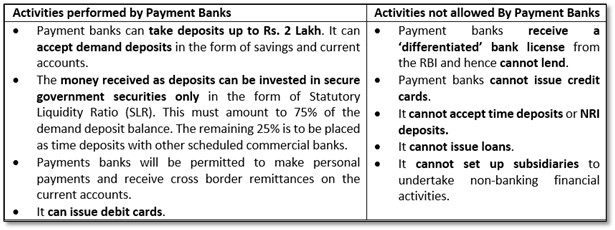
Scheduled Banks
- The banks in the Indian banking system are sub categorized as Scheduled Banks, Non-Schedule Banks, Private Banks and Public Banks.
- Scheduled banks are those banks that are listed under Schedule II of the Reserve Bank of India Act, 1934.
- The bank's paid-up capital and raised funds must be at least Rs. 5 lakh to qualify as a scheduled bank. These banks are liable for low interest loans from the RBI.
- They also have membership in clearing houses.
- They also have numerous obligations to fulfil such as maintaining an average daily Cash Reserve Ratio with the central bank.
- Main Functions of scheduled banks: Acceptance of deposits from the public, Lending facility, Provide demand withdrawal facility, Transfer of funds, Issue of drafts Provide customers with locker facilities, dealing with foreign exchange.
- Apart from all this, scheduled banks are considered to be more stable and therefore it is unlikely that it would hurt the rights of the depositors. At the same time, scheduled banks are authorised to borrow funds from the Reserve Bank of India.
Sources:
- Airtel Payments Bank designated as scheduled bank
- Inclusion of “Airtel Payments Bank Limited” in the Second Schedule of the Reserve Bank of India Act, 1934
- Paytm Payments Bank gets RBI approval to operate as scheduled bank
- What is scheduled bank status: All you need to know
- Definition of 'Payments Banks'
- Scheduled Bank
Five of world’s most powerful nations pledge to avoid nuclear war
In News
US, Russia, China, the UK and France who are permanent members of the UN Security Council have recently agreed that ‘nuclear war cannot be won’
About the News
- Five of the world's nuclear powers viz. China, France, Russia, UK and the US have jointly pledged to prevent the proliferation of nuclear arms agreeing that nuclear war is not an option.
- The parties have vouched to prevent further spread nuclear weapons and such weapons should only serve defensive purposes, deter aggression, and prevent war.
- The joint pledge was issued ahead of the latest review of the Treaty of the Non-proliferation of nuclear weapons (NPT).
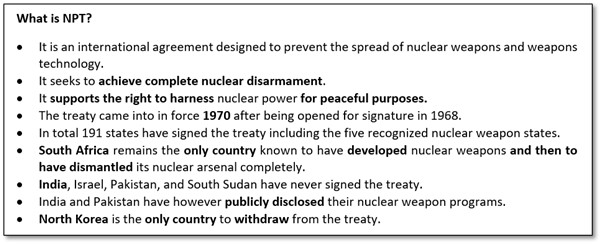
What are the advantages of commitment?
- Effective measures will help in cessation of the nuclear arms race, nuclear disarmament at an early date.
- It will help ushering a treaty on general and complete disarmament under strict and effective international control."
- It will help increase mutual trust and replace competition among major powers with coordination and cooperation.
- It will help reduce the level of international tensions.
What are the major Challenges?
- States’ Continuing Proliferation Efforts: Although the international community has tried to reduce the potential dangers associated with the spread of nuclear weapons, some states, like North Korea, have increased their efforts with regard to nuclear proliferation.
- Competition among the Great Powers: The increased competition between the great nuclear powers allows for incongruence to develop in the international cooperation against nuclear proliferation efforts, thereby weakening the effectiveness of the NPT regime including sanctions.
- Global Resurgence of Nationalism: In recent years, Nationalism is seemingly on the increase in every continent leading to opposition to non-proliferation obligations and adherence to the non-proliferation regime.
- The Spread of Nuclear Technology and Burdens on the IAEA Safeguards: Spread of nuclear technology worldwide has increased the burden on the IAEA safeguard thereby reducing the effectiveness of its monitoring of cheating activities unless the IAEA is able to expand its capabilities.
- Growing Polarization among NPT Member States: Growing polarization may pose structural threat as at present NPT fundamentally counters both the existing nuclear order and granting exceptions to compliant states.
Sources:
Revised IPO Rules by SEBI
In News
The Securities and Exchange Board of India (SEBI) has recently come out with fresh rules for initial public offerings (IPOs).
Understanding the new Rules
The new rules will oversee the following:
- How companies price their shares
- How they use the money that they receive from investors
- How much of their stake, promoters of a company can sell during an IPO
- How soon can anchor investors sell the stakes they picked up before the IPO.

Changes according to the new rules:
- Price Band: The price band of an IPO should be set in such a way that the ceiling price is at least 105% of the floor price.
- Limited fund for purchase of other businesses: The companies will not be allowed to use more than 35% of the money that they collect through IPOs to fund the purchase of other businesses, unless they offer sufficient details.
- Ceiling on the stake: Promoters with a stake of over 20% in a company cannot sell more than half of their stake in an IPO.
- Time stipulation for Anchor Investors: Anchor investors will not be able to sell more than half their shares before 90 days from the date of the IPO, against the current time stipulation of 30 days.
Need for the Regulation
- Stock markets across the globe have been witnessing a boom in IPO offerings and in India alone, capital worth over ₹1 trillion has been mopped up through IPOs in 2021.
- It is natural for both the number and the size of IPOs to rise during a bull market (where an investor expects prices to rise).
- Companies see such bull markets as an opportunity to collect the necessary funds for their growth as there is a lot of investor money chasing the stocks. They also see the IPO boom as an opportunity to sell their stake in the business at an attractive price.
- However, a lot of companies that raised funds through IPOs in 2021, such as Zomato, Paytm etc., are loss-making that puts investors who have invested in these at the risk of huge losses. Paytm, for instance, has lost more than one-third of its value since it was listed for trading.
- Thus, the new regulation is believed to ensure that promoters of companies will have more skin in the game. Its price band rule seems to be aimed to tackle the trend among companies of setting a narrow price band for their issues. SEBI believes that a narrow price band impedes the price discovery process.
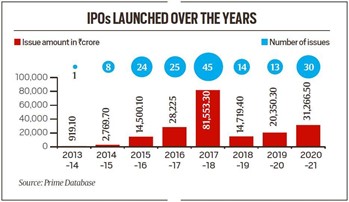
Concerns related to the new regulations
- Maandating companies to be specific about how they will use the money that they collect through IPOs can affect flexibility as business conditions can change fast in the real world.
- The restriction on anchor investors can affect liquidity in the market as many large investors may not be willing to hold their investments over 90 days and thus decide to completely abstain from participating in IPOs.
- Some critics also raise the question of whether SEBI should be trying to handhold investors at all when it comes to making investment decisions. They believe investors, who have the most to lose or gain from their investment decisions, are best equipped to conduct the necessary due diligence before investing in IPOs.
- Setting narrow price bands could be a way to avoid valuation uncertainties that can affect fundraising.
Source:
- IPO for Beginners
- Explained | How will revised IPO rules affect the market?
- Sebi’s new IPO and preferential issue rules: Applying the brakes?
Image Source:
- https://financialfreedom101.blog/2020/09/05/what-is-an-ipo/
- Making sense of the IPO rush: What to look for before investing?
Discovery of Dwarf Planet Eris
On January 5, the dwarf planet Eris was discovered on Jan. 5, 2005, from data obtained on Oct. 21, 2003 during a Palomar Observatory survey of the outer solar system. Eris is one of the largest known dwarf planets in our solar system. It's about the same size as Pluto but is three times farther from the Sun. Eris is named for the ancient Greek goddess of discord and strife. The name fits since Eris remains at the center of a scientific debate about the definition of a planet. The surface of Eris is extremely cold, so it seems unlikely that life could exist there. With a radius of about 722 miles (1,163 kilometers), Eris is about 1/5 the radius of Earth. Eris, like Pluto, is a little smaller than Earth's Moon. As Eris orbits the Sun, it completes one rotation every 25.9 hours, making its day length similar to ours. Eris has a very small moon called Dysnomia. Eris has no known rings. Dwarf planet Eris is a member of a group of objects that orbit in a disc-like zone beyond the orbit of Neptune called the Kuiper Belt.

Source:
All India Judicial Service: Problems and Prospects
In News
The proposal to set up an All India Judicial Service (AIJS) has gained momentum as the Centre is making fresh attempts to build consensus with the state governments.
Introduction
- Article 312 (1) of the Constitution provides for the creation of an AIJS.
- The AIJS is a reform push where Judges of the lower judiciary are proposed to be recruited centrally and assigned to states in the same way as All India Services (IAS, IPS and Indian Forest Service).
- The exact nature of this centralization is not clear due to lack of a clearly articulated vision.
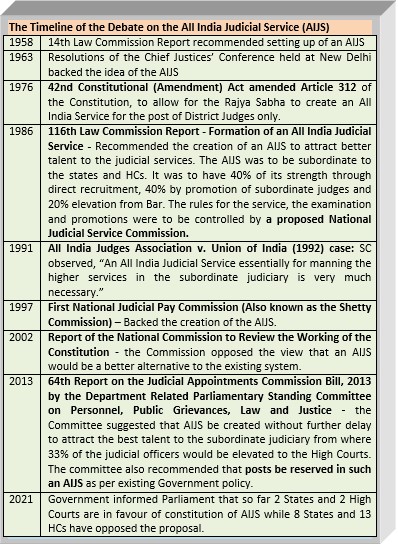
Why has the AIJS been proposed?
- In 1958, the Law Commission in its ‘Report on Reforms on Judicial Administration’ first proposed the idea of a centralised judicial service.
- The idea was to ensure an efficient subordinate judiciary, to address structural issues such as varying pay and remuneration across states, to fill vacancies faster, and to ensure standard training across states.
- In repeated replies to Parliament over the years, the Ministry of Law and Justice had asserted that a properly framed AIJS is important to strengthen the overall justice administration system and it would pave the way for the induction of suitably qualified fresh legal talent selected through a proper all-India merit selection system.
- Moreover, the proponents of AIJS suggest it will address the issue of social inclusion by enabling adequate representation to the deprived sections of society.
- As per a 2018 report, Other Backward Class (OBC) accounted for only 12% of judges in the lower judiciary in 12 states. This is far below the estimated share of OBCs in the entire population.
- As for SC and STs, according to government data, they made up less than 14% and 12%,
- It will also diversify the gender composition in judiciary as they will be directly recruited through the exam and will be provided equality of opportunity. Currently there are only 30% women judges in the lower courts and above 10% in high courts. The Supreme Court has only 4 women judges out of 33.The current Chief Justice of India asserts that women have a right to 50% reservation in the judiciary.
- AIJS would be helpful to fill the judicial vacancies. As of January 2021, the working strength of the lower judiciary was 19,318 as against the sanctioned strength of 24,247 — which means almost 5,000 vacancies. The judge-to-population ratio in India is about 19 judges per 10 lakh population, compared to the US and UK’s 107 & 50 judges respectively. In fact, the Law Commission of India had recommended 50 judges per 10 lakh population.
- Filling up of judicial vacancies could also lead to reduction in pendency of cases. The Union government contends that the pendency in the district and lower judiciary stood at nearly 4 crore cases, thus accounting for the bulk of more than 4.40 crore cases pending across Indian courts.
What is the opposition to the AIJS?
- Challenge to Federal structure: A centralised recruitment process is seen as an encroachment on the powers of states granted by the Constitution and would go against the spirit of federalism and the doctrine of basic structure. This is the main contention of several states.
- Unique concerns of states: Language and representation are key concerns highlighted by states.
- Judicial business is conducted in regional languages, which could be affected by central recruitment.
- Also, it has been argued reservations based on caste, and even for rural candidates or linguistic minorities in the state, could be diluted in a central test.
- Against separation of powers: A central test could give the executive a foot in the door for the appointment of district judges, and dilute the role of High Courts in the process. Creation of AIJS may lead to the erosion of administrative control of high courts over the lower judiciary and impair the judiciary’s independence.
- Structural issues unresolved: Issues such as pay scale, promotion in lower judiciary and elevation to higher judiciary etc. will remain there despite the creation of AIJS. Experts argue that increasing pay across the board and ensuring that a fraction of High Court judges are picked from the lower judiciary, may help better than a central exam to attract quality talent.
What is the judiciary’s view on the AIJS?
- The Supreme Court in All India Judges’ Assn. vs. Union of India (1992) directed the Centre to set up an AIJS. In a 1993 review of the judgment, however, the court left the Centre at liberty to decide on the AIJS.
- In 2017, the Supreme Court took suo motu cognizance of the issue of appointment of district judges, and mooted a “Central Selection Mechanism”. It circulated a concept note to all states stating that the move was only to ensure that vacancies were filled in a timely manner without tempering with the federal structure.
Ensuring judicial independence in context of the AIJS
- Currently, the independence of District Judges from the State Governments is guaranteed as the High Courts play a significant role in the appointment, transfer and removal of District Judges as provisioned under Article 233, 234 and 235.
- There must be a mechanism to insulate the proposed AIJS from executive at both the central and state level. The 116th report of the Law Commission dealt with this issue and recommended that appointments, postings and promotions to the AIJS be made by a proposed National Judicial Service Commission consisting of retired and sitting judges of the Supreme Courts, members of the bar and legal academics.
- However, creation of such a body will result in the immense concentration of power in few hands. Designing such a Commission to ensure judicial independence is not an easy task. Only when there is a wide-ranging consensus on the shape of the institutional arrangement to control the AIJS, should the Government of India proceed with its creation.
AIJS and the federalism debate
- Although India has integrated judiciary for the purpose of enforcing laws, it has a federated system for judicial administration. In a country like India, with such diversity of customs, religion and language, it may be more politically prudent, to maintain a decentralized system of recruiting judges for the District and Subordinate Judiciary since these judges are the first point of contact for millions of Indians seeking justice before Indian courts.
- The 42nd Constitutional (Amendment) Act, 1976 amended Article 312 and established a relatively simple pathway to create the AIJS without having to go through the rigours of the procedure laid down in Article 368.
- The 42nd Constitutional Amendment also amended the Seventh Schedule to shift the power of “Administration of justice; constitution and organization of all courts, except the Supreme Court and the High Court” from the State List, to the Concurrent List.
- The amendment allows both Parliament and the State Legislatures to enact laws with respect to the constitution and organization of District and Subordinate courts.
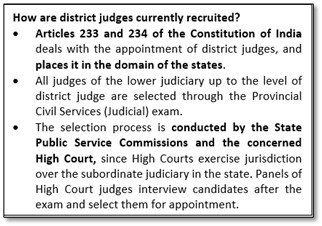
Conclusion: The proposal of setting up of an AIJS has been discussed on points of eligibility, age, selection criteria, qualification, reservations etc. in a meeting chaired by Minister of Law and Justice in 2017. Setting up AIJS was also deliberated in a meeting of the Parliamentary Committee on the Welfare of SCs/STs in 2021. In view of the existing divergence of opinion amongst the stakeholders, the Union Government is engaged in a consultative process with the stakeholders to arrive at a common ground.
Question: Judicial independence and federal challenges are two key concerns among others which may restrict the intended benefits of the envisaged AIJS reforms. Critically discuss.
Sources:
- Status of All India Judicial Service
- Setting up of All India Judicial Service
- All India Judicial Services
- A Primer On The All India Judicial Service
- All India Judicial Service won’t solve pendency
- Centre likely to make fresh attempt to reach consensus with states for an all-India judicial service
- Making sense of the proposal for an All India Judicial Service
- EXPLAINED: A Recruitment Pipeline For Judges Like IAS? Why Centre Is Pushing For All India Judicial Service
- Explained: Lower judiciary and centralised recruitment debate
- Alarming gender disparity in judiciary: 4 women judges out of 33 in SC, 66 out of 627 in HCs
Frazil ice
This is image of Frazile ice formation, which is a rare phenomenon. Frazil ice is a collection of loose, randomly oriented, plate or discoid ice crystals formed in supercooled turbulent water. It occurs when water bodies experience extremely cold temperatures. The air temperature surrounding water streams is well below freezing and much colder in comparison to the water. These small bodies of water are supercooled, meaning the temperature of the water drops below its normal freezing point, but remains as a liquid. This is where we start to see the formation of ice crystals on the surface of the water. These ice crystals are somewhat soft and have little structure to them. Since the flow of water is constant and turbulent, the soft ice crystals that do form are not able to completely freeze solid. With less turbulent streams, more ice is able to accumulate quicker, which creates the illusion of a disappearing river.

Source:
Sustained Business Bay
- Context: Haryana Government is to launch 1,000 acre Global city project in Gurgaon.
- The state government designated it as a Special Zone with mixed land use that allows residential, commercial and recreational facilities in the area.
- This project is expected to become an important economic and financial hub on the Delhi-Mumbai industrial corridor.
- On the model of Dubai’s Business Bay, it will have shopping malls, commercial and residential buildings.
- Dubai Bay Square is a mixed-use community within Business Bay. The entire development is a pedestrian-only zone, and includes walkways over canals. Bay Square hosts numerous small and medium-sized enterprises with smarter access to its citizens.
- The Global City will have walking, cycling and service lanes. It will have non-stop lanes too where vehicle crossing will take place via underground lanes only.
- Mainly, only green industries will be permitted here like manufacturing of items related to electronics, bio-technology, and information technology.
- The commercial city will have four dedicated towers. For example, one may be for gifts only, another for furniture items, and third may be for residential utilisation items.
- Haryana State Industrial and Infrastructure Development Corporation Ltd (HSIIDC) will develop the infrastructure and auction the big plots.

Source:
Sahitya Akademi Award
- Context: The Sahitya Akademi has recently announced its awards for 2021 for literary works in 20 languages including Assamese and English.
- Sahitya Akademi prizes are awards crowned to the most outstanding books of literary merit published in any of the major Indian languages recognised by the Akademi.
- Besides the 22 languages enumerated in the Constitution of India, the Sahitya Akademi has recognised English and Rajasthani.
- It has been awarded every year since its inception in 1954 and the award includes an engraved copper plate, shawl and an amount of Rs 1 lakh.
- In order to be eligible for the award, the book must be an outstanding contribution (creative and critical) to the language and literature to which it belongs and must not be a translation.
- The decision of the winners shall be made by the 3-member Jury who are selected by the President.

Source:
Image Source:
Yes Bank’s AT-1 Bonds
- Context: RBI can have change of mind for regulating Additional Tier-1 bonds of Yes Bank.
- In order to maintain stronger balance sheets for banks in global financial crises, Central banks got together to formulate new rules called the Basel-lll norms.
- AT-1(Additional Tier-1 bonds) is a type of unsecured, perpetual bonds that banks issue to shore up their core capital base to meet the Basel-III norms.
- These bonds have no maturity. Instead, they carry call options that allow banks to redeem them after 5 or 10 years. But banks are not obliged to use this call option and can opt to pay only interest on these bonds for eternity.
- Banks issuing AT-1 bonds can skip interest payouts for a particular year or even reduce the bonds’ face value without getting into risk with their investors, provided their capital ratios fall below certain threshold levels.
- If the RBI feels that a bank is tottering and needs a rescue, it can simply ask the bank to cancel its outstanding AT-1 bonds without consulting its investors.
- This is what has happened to YES Bank’s AT-1 bond-holders who are said to have invested ₹10,800 crore.

Source:
Image Source:
New Development Bank
- Context: India has welcomed Egypt’s entry as the fourth new member of the New Development Bank (NDB).
- NDB is a multilateral development bank (MDB) established by Brazil, Russia, India, China and South Africa (BRICS) in 2014.
- Its main objective is to finance infrastructure and sustainable development projects in BRICS and other emerging economies and developing countries towards global growth and development.
- The Bank supports public or private projects through loans, guarantees, equity participation and other financial instruments.
- During the sixth BRICS Summit in Fortaleza (2014), the leaders signed the Agreement establishing the New Development Bank (NDB).
- In the Fortaleza Declaration, the leaders stressed that the NDB will strengthen cooperation among BRICS and will supplement the efforts of multilateral and regional financial institutions for global development, thus contributing to collective commitments for achieving the goal of strong, sustainable and balanced growth.
- It is headquartered at Shanghai, China.
- United Arab Emirates (UAE), Uruguay and Bangladesh joined NDB as its members in 2021.
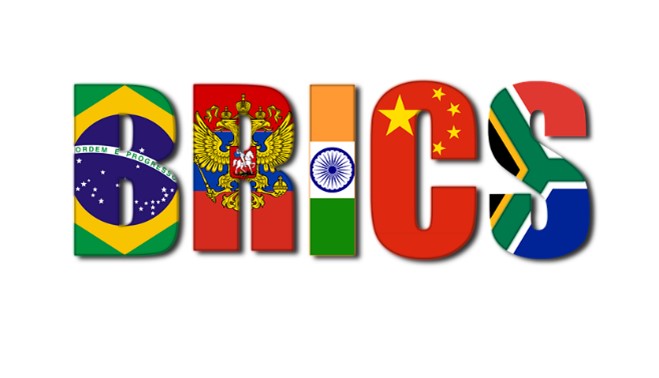
Source:
The uneven nature of India’s export growth: HBL
Essence: The article talks about the strong recovery in international trade which is expected to reach record high $22 trillion in 2021. Though the growth was witnessed in global export but it was not evenly spread across the sectors. Certain sectors performed well like petroleum products but sectors like cars and electronic components suffered due to semiconductor shortage. For India, issues that posed major challenge were ambiguity over fisheries subsidies along with unresolved trade disputes.
Overall, a recovery was seen in the global demand but the supply side was marred due to shortage of containers leading to increase in prices. What India needs is a logistic policy, strengthening of export infrastructure and diversification of export basket to include to include technology intensive sectors. A clear cut policy on logistics will help reduce logistics could leading to increased competitiveness of Indian products in global markets.
Why you should read this article?
- To understand the trends in global export.
- To understand the reason behind supply side constraints.
- To understand what steps India should take to strengthen its global exports.
Source:
Trickle-down Wage: Analysing Indian Inequality from a gender lens: ORF
Essence: As per World Bank, millions of South Asians are being pushed into extreme poverty due to the impact of Coronavirus pandemic. India specifically witnesses the most extreme cases of income inequalities. One of the most important dimensions of this inequality is Gender Based discrimination. The World Inequality Report 2022 highlights that Indian women’s share in labour income and participation in labour market is worse than many South Asian countries.
The article highlights that factor like unpaid care work, patriarchal social norms, cultural barriers, harassment etc. have made the situation of working women worse. This article suggests a policy change which revisits and rethinks labour distribution, formal and informal structures, social security mechanism, gender sensitive fiscal policies etc. for the benefit of working women.
Why to read this Article?
- To understand with the help of various reports that how gender based discrimination is one of the important elements of the rising income inequalities in India.
- The article becomes very relevant for examination as it mentions many important reports and their highlights at one place and have high chances to be asked in Prelims and Mains (Women issues, GS I, GS II and Essay).
Source:
Placing biodiversity at the centre of economic decision-making: HT
Essence: The article talks about the importance having a robust Biodiversity Act (BDA) with efficient access and benefit sharing (ABS) compliance. It highlights that due to increasing disputes related to ABS in the act, the recent amendments have, although, streamlined the compliance issues, but is drifting away from the true spirit of the act, i.e., Biodiversity conservation. India has announced to set aside 17.41% of its geographical area to reach its biodiversity conservation targets along with 30x30 targets. ABS which is part of the biodiversity act needs to be robust as it is one of the only few mechanisms which generates and channelizes funds for biodiversity conservation. It also provides benefit to the custodians of traditional knowledge.
The Article highlights that the governments should revamp BDA and should place biodiversity at the core of all economic decision-making. The services provided by healthy ecosystems influence complex global phenomena such as regulating climate patterns, mitigating the effects of soil erosion, and natural calamities. True monetary value can’t be attributed to the biodiversity of a country, but such calculations can highlight the importance of biodiversity in all aspects of a nation’s economy. On the global scale creation of finance mechanisms on the lines of UNFCCC for CBD shall further aid the conservation efforts. On domestic front, involvement of state governments and including concepts such as ‘Natural Capital’ into GDP calculation can highlight the contribution of ecosystem services in a country’s economy.
Why you should read this article?
- The article talks about the importance of a robust Biodiversity Conservation Act.
- The article talks about keeping Biodiversity at the core of economic decision making as well as creation of strong finance mechanisms.
Source:
Sustainable answer for growing pest problem
Background
- Rodents like gophers and mice wreak havoc on vineyards, causing owners to make drastic decisions to control them.
- Instead turning to rodenticides to deter pests, a new study in California’s Napa Valley is testing the effectiveness of owls to manage the problem.

How California has a more natural approach?
- Four-fifths of the wineries in Napa Valley used owl nest boxes and noticed a difference in rodent control. The have a four-month nesting season, during which they spend about one-third of their time hunting in the fields.
- A family of barn owls may eat as many as 1,000 rodents during the nesting season or around 3,400 in a single year.
- Practicising these, the California Department of Pesticide Regulation placed tougher limits on rodenticides. These pesticides lead to gruesome deaths via internal bleeding for the rodents that ingest them.
- Most of the vintners in their study no longer use the rodenticides since adding nest boxes to their properties.
- This has led to the safe ‘food chain’ cycle which is very vital for conservation of Natural resources we have today.
Quote:”A sustainable agriculture is one which depletes neither the people nor the nature”
– Wendell Berry
Source:
Share the article
Get Latest Updates on Offers, Event dates, and free Mentorship sessions.

Get in touch with our Expert Academic Counsellors 👋
FAQs
UPSC Daily Current Affairs focuses on learning current events on a daily basis. An aspirant needs to study regular and updated information about current events, news, and relevant topics that are important for UPSC aspirants. It covers national and international affairs, government policies, socio-economic issues, science and technology advancements, and more.
UPSC Daily Current Affairs provides aspirants with a concise and comprehensive overview of the latest happenings and developments across various fields. It helps aspirants stay updated with current affairs and provides them with valuable insights and analysis, which are essential for answering questions in the UPSC examinations. It enhances their knowledge, analytical skills, and ability to connect current affairs with the UPSC syllabus.
UPSC Daily Current Affairs covers a wide range of topics, including politics, economics, science and technology, environment, social issues, governance, international relations, and more. It offers news summaries, in-depth analyses, editorials, opinion pieces, and relevant study materials. It also provides practice questions and quizzes to help aspirants test their understanding of current affairs.
Edukemy's UPSC Daily Current Affairs can be accessed through:
- UPSC Daily Current Affairs can be accessed through Current Affairs tab at the top of the Main Page of Edukemy.
- Edukemy Mobile app: The Daily Current Affairs can also be access through Edukemy Mobile App.
- Social media: Follow Edukemy’s official social media accounts or pages that provide UPSC Daily Current Affairs updates, including Facebook, Twitter, or Telegram channels.





